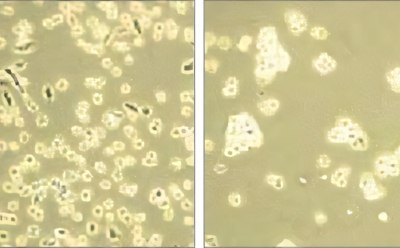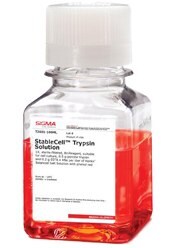Cell Dissociation Reagents

In order to replicate their native environments, adherent cell phenotypes (such as epithelial cells) are typically seeded onto tissue culture-treated surfaces, to which they attach in order to survive and proliferate. For propagation, enumeration, and downstream analysis, adherent cells and cells from solid tissues must be dissociated to create suspensions. Single-cell suspensions are required for cell counting, reseeding for subculture, and cellular assays/analysis.
Dissociation reagents can include naturally occurring enzymes or gentler non-enzymatic alternatives. These reagents work by chelating calcium to prevent cadherins from attaching to the surface or one another, releasing cells from these surfaces during the culturing process. Cell dissociation reagents that are used in the cell culture workflow may be specific for extracellular matrix (ECM) substrates.
Products

Trypsin, Recombinant Trypsin, StableCell™ Trypsin
Trypsin is a serine protease and one of the most common detachment enzymes used with adherent cell lines and for tissue dissociation. Crude trypsin preparations have typically been found to be more efficient for both applications, but incubating cells with a high trypsin concentration or for too long risks damage to cell membranes and can kill the cells. Cultured cells are most commonly removed from the culture substrate by treatment with trypsin in combination with EDTA (ethylenediaminetetraacetic acid), in which the concentration of trypsin can range from 0.025% to 0.5%.
StableCell™ Trypsin solutions were developed to perform cell detachment as standard trypsin solutions do, without the need to aliquot, freeze, and thaw the trypsin. This saves significant time by eliminating the need to aliquot and wait for trypsin to thaw for cell passaging or experiments and frees precious space in lab freezers. Our StableCell™ Trypsin solutions are recommended for storage at 2-8 °C, but our studies indicate that StableCell™ Trypsin retains >90% activity and performance even when stored at 37 °C.
Collagenase and Dispase
Collagenase cleaves the peptide bonds in native, triple-helical collagen. Because of its unique ability to hydrolyze native collagen, it is widely used in isolation of cells from animal tissue. Collagenases occur in a variety of microorganisms and in many different animal cells. The most potent is the “crude” collagenase secreted by the anaerobic bacterium Clostridium histolyticum.
Dispases are rapid, effective, gentle, and neutral proteases that can separate intact epithelial sheets in culture from the substratum. Dispase I has been used to digest lung tissue, and to process cells for flow staining, as well as for murine CD4 T cell isolation.
Dissociation Reagents for Specialty Cultures
For dissociating or detaching cell and tissue types that may require gentler enzymatic activity, Accutase® and Accumax™ solutions use efficient enzymes at lower concentration. These solutions:
- Efficiently detach embryonic and neuronal stem cells
- Gently detach to preserve cell viability & can enhance cell yield
- Do not require neutralization
Single Cell Analysis
Single cell analysis requires viable single cells as an input when working with tissue samples. With these analyses, researchers can study variations in cell culture populations for stem cell, immunology, and cancer research. Discover our high-quality disassociation reagents, which are essential to optimize protocols, create best practices, and ensure reliable single cell analysis data.
Related Resources
- Brochure: Enzymes for Cell Dissociation and Lysis
Including enzymes for cell detachment and tissue dissociation, enzymes for cell lysis and protoplast preparation, and proteases for mitochondria isolation
- Trypsin Cell Dissociation Protocol
Trypsin is commonly used for dissociating adherent cells from surfaces. A wide variety of trypsin solutions are available to meet your specific cell line requirements.
- Tissue Dissociation Guide: Collagenase, Dispase, and Liberase Enzyme Types
Collagenase Guide.Collagenases, enzymes that break down the native collagen that holds animal tissues together, are made by a variety of microorganisms and by many different animal cells.
To continue reading please sign in or create an account.
Don't Have An Account?